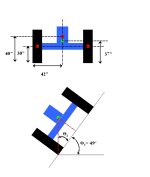I've been thinking this same thing. This weekend I took the family to the Cincinnati Zoo and along I-75 the mowing crews were doing some of the death-defying things already mentioned here. Then last night was trying to spread out some piles of dirt left over from cleaning out a pond. There were several times I would have registered on that pucker scale, especially being an inexperienced tractor guy.
So, how far is too far? As Soundguy mentioned it totally depends on your set up, but the math is the same whatever you drive. For me, I did some quick estimates on my 6610. My tires are about 60" in diameter and with rims I estimate weigh 1,200 lbs each. The body of the tractor should be in the 6,000 range I think with a rough guess at center of gravity (COG) of about 40". So figuring out the moment of each wheel and the body, that gives an overall center of gravity of about 37". My newly narrowed wheel base is 84." With that, in a static condition, you can figure out how far is too far: The red dots are the approx COG of each wheel and the body. The green dot is approx COG for the whole thing. The compliment of the angle made between your COG, the edge of the wheel and your centerline is how far too far is...

The answer for me
should be 49°. However, two things come in to play.
First is traction. In order to maintain traction the force of friction between the tires and the ground would have to overcome the component of gravity that would act on the tractor normal to the surface of contact. I seriously doubt I'd have that much traction unless the ground was soft and the tires could dig in. So in this case, hard ground would be better because you'd want it to slip rather than tilt. Many of you have seen this actually happen, the "dirt track" method of mowing.
Second though is momentum, life on a tractor is not "static." This is the one that will reach up and bite you on the rump. When you are trucking along and hit a bump or a rut, the intertia of the tractor can easily cause it to flop over. Anything on the 3ph above the COG will only make this worse.
It's good to see for me how that math works out, but I want a huge safety factor to keep a quick dip from sending me over.
Play it safe.
